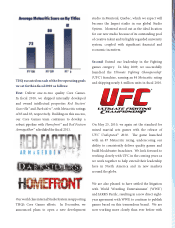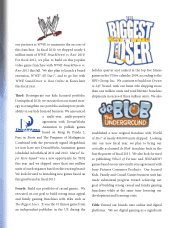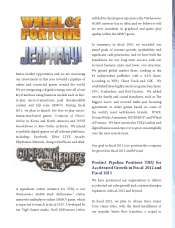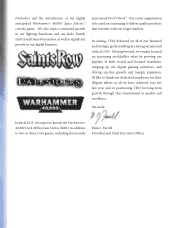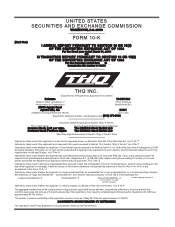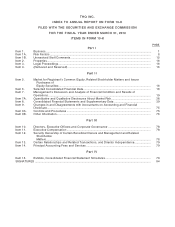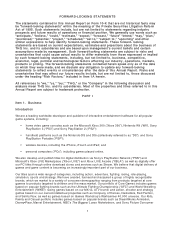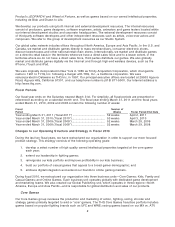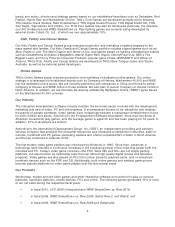THQ 2010 Annual Report Download - page 13
Download and view the complete annual report
Please find page 13 of the 2010 THQ annual report below. You can navigate through the pages in the report by either clicking on the pages listed below, or by using the keyword search tool below to find specific information within the annual report.5
The development cycle for a new game depends on the platform and the complexity and scope of the game.
Additionally, when developing an intellectual property into a game that is simultaneously being made into a
motion picture, our development schedule is designed to ensure that our games are commercially available
by the motion picture’s theatrical release. Our development cycles generally range as follows:
• 18-36 months for our console and PC games;
• 9-18 months for our handheld games;
• 6-18 months for our casual/social online games; and
• 1-5 years for our Core Online Games (with the longer end of that range for our large scale MMO
games).
These development cycles require that we assess whether there will be adequate retailer and consumer
demand for a game and its platform well in advance of its release.
The investments in our product development, prior to when a game reaches technological feasibility, and
other non-capitalizable costs, are recorded as product development expenses in our consolidated statement
of operations. In fiscal 2010, 2009, and 2008, we had product development expenses of $87.2 million,
$109.2 million, and $128.9 million, respectively.
Upon completion of development, each game is extensively play-tested by us to ensure compatibility with the
appropriate hardware systems and configurations, and to minimize the number of bugs and other defects
found in the products. If required, we also send the game to the manufacturer for its review and approval. To
support our products after release, we provide online access to our customers on a 24 hour basis as well as
operator help lines during regular business hours. The customer support group tracks customer inquiries, and
we use this data to help improve the development and production processes.
Manufac turing Our Produc ts
Other than games we release for sale on PCs, digital download, or wireless devices, our video games are
manufactured for us by the platform manufacturers or their authorized vendors. We contract with various DVD
replicators for the manufacturing of our PC products.
The platform game manufacturing process begins with our placing a purchase order with a manufacturer. We
then send the approved software code to the manufacturer (together with related artwork, user instructions,
warranty information, brochures and packaging designs) for manufacturing. We order a sufficient amount of
product units to meet the requirements of our customers, based upon our sales forecasts for a game.
Because we do not manufacture our products ourselves, we do not carry significant amounts of inventory to
meet rapid delivery requirements of customers or to assure ourselves of a continuous allotment of goods from
manufacturers. At the time our product unit orders are filled by the manufacturer, we become responsible for
the costs of manufacturing and the applicable per unit royalty on such units, even if the units do not
ultimately sell.
We are required by our platform licenses to provide a standard defective product warranty on all of the
products sold. Generally, we are responsible for resolving, at our own expense, any warranty or repair claims.
We have not experienced any material warranty claims, but there is no guarantee that we will not experience
such claims in the future.
Marketing Our Products
The manner in which we drive consumer demand for our brands across the globe has evolved significantly in
recent years as we have expanded our franchise portfolio. At the global brand management level, we take a
disciplined approach to defining and refining positioning for our key game releases. We implement extensive
consumer research including concept and play testing that is conducted in conjunction with our development
studios and third party developers. This research, conducted prior to the commencement of a product and
continued through a project’s development, allows us to create game experiences that are optimally targeted
to the appropriate demographic via content and play patterns that provide maximum marketability to
consumers.


